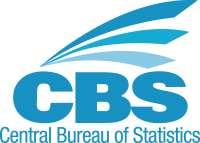Victims Survey
Introduction
From April to mid May of 2014, a Victims Survey was held in Curaçao. Previously, in 1981 and 1992, this survey had been carried out in Bonaire, Curaçao and St. Maarten (and in 1981 also on Aruba) as part of the technical assistance program of the Dutch Research and Documentation Centre, making use of the fieldwork infrastructure of the Central Bureau of Statistics.
The survey was repeated by the CBS on Bonaire and Curaçao in 1995, while in St. Maarten it had to be cancelled due to the damage sustained at that time from Hurricane Louis. Another Victims Survey was carried out in Bonaire, Curaçao and St. Maarten in 2008. As a result of the constitutional changes as of October 10, 2010 that split up Curaçao and St. Maarten as autonomous countries and Bonaire, St. Eustatius and Saba as public bodies resorting under the Kingdom, the responsibility for conducting research now lies with each autonomous country. The first Victims Survey for the Country of Curaçao was held in 2014.
One feature of the 2014 Victims Survey was a so-called Opinion Poll on Restorative Justice. Restorative Justice is an alternative approach to dealing with crime issues. It involves bringing together the victim and the offender (by mutual agreement) through a mediator guiding the process, and family members and neighbors may also participate if desired. The mediator will explain to the participants in advance what to expect from the meeting. These meetings make it possible for victim and offender to actually talk. The participants receive the opportunity to express how they feel about the conflict or offence and offer suggestions on how to resolve the issue. One condition for such a restorative session, however, is that the offender should show remorse and be willing to make amends. Another condition is that the meeting must proceed without any physical or verbal abuse. Restorative Justice has been applied in several countries as an alternative to resolve conflicts, offences and legal cases.
Objective
The survey’s objective is twofold: (1) measuring “frequent crime” on Curaçao and (2) polling the respondent’s opinion on restorative justice.
The crimes in question involve individuals and households. The crime rate is measured based on the victimization of the individuals and households.
Also measured are the reporting rate and the respondents’ feelings of fear and anxiety in connection with crime in society.
Social phenomena are subject to change, and this also applies to crime. Certain offences, such as domestic violence, sexual violence and consumer fraud tend to be more frequent. In addition, society must deal with offences, such as identity fraud (skimming, fishing, pharming), that are part of the modern developments taking place worldwide. The measurement instrument must therefore be adjusted from time to time, based on social developments.
The opinion poll on Restorative Justice focuses on the respondents’ opinion on whether they would be willing to meet the the offender to speak about the issue if they are ever victimized, under which circumstances they would or would not be willing to do so, and to what extent they consider the restorative approach to be useful.
Definition
1. What is the “frequent crime” rate on Curaçao?
2. How often do victims report such offences to the police, what motivation do they offer for not reporting and, as far as victims who did report the offence is concerned, how satisfied do they report being with the efforts of the police?
3. To what extent does the population harbor feelings of fear and anxiety in connection with crime?
4. What is the respondent’s opinion on Restorative Justice?
Sample survey
A sample with a random start is taken from the Curaçao Civil Registry’s address database. From each household contacted at an address, the person is chosen whose birthday comes first after the start of the survey and who is also 16 years of age or older. This is done to prevent any overrepresentation of those with a higher chance of being at home, such as homemakers, retirees, the unemployed and students.
A weighting factor is calculated and applied to correct for the distortion caused by the sample’s sex and age ratios. Tables are produced for these corrected figures.
Frequency
It is recommended to carry out a Victims Survey every five years.
Publication
The results of the Victim Survey are presented in the publication “Results of the Victim Survey 2014”, which can be downloaded free from the CBS website: Publications/Other Publications. The results are also presented to the media through a press release. Additionally, analyses of the Victim survey are published in Modus, the CBS’s statistics magazine
